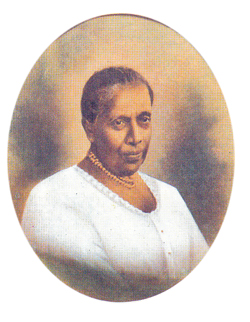The birth of the founder of Visakha Vidyalaya A major philanthropist Mrs. Jeremias Dias, best remembered as the founder of Visakha Vidyalaya, the leading Buddhist girls school in Sri Lanka was born on July 11, 1858. Hailing from Panadura, Selestina Rodrigo married Jeremias Dias, a wealthy plantation owner as a teenager. After being widowed when she was 44, then a mother of eight children, she spent her wealth to promote the cause of Buddhist education and assisted in the campaign to resurrect Buddhism in this country.
Meanwhile, when Ananda College was refused a government grant due to the lack of a laboratory, she built a modern laboratory for the school which helped it to be recognized as an institute of higher education. The Jeremias Dias Buddhist Educational and Charity Trust Fund established by her, awards scholarships with monthly grants to a large number of needy Buddhist students including undergraduates. She helped the poor constantly, distributing foodstuff, clothes and other needs to them every weekend. The innumerable religious and social service activities initiated by her have helped a large number of organizations to fulfill their objectives. She was on the honours' list of the monarch of England and was awarded a MBE (Member of the British Empire). She died on March 26, 1933.
'Ceylon Times' begins publication The first issue of 'Ceylon Times,’ a new paper started to oppose the 'Observer' appeared on July 11, 1846. The newspaper, which became the 'Times of Ceylon' in 1883, prospered after John Capper, a sub-editor in the London newspaper 'Globe' bought it in 1858 and became its editor. Its object was to further the interests of the mercantile community.
At the time 'Ceylon Times' was started, at least three English newspapers were published during the week. While the 'Observer' came out on Monday and Thursday, 'the 'Times' was published on Tuesday and Friday. The third newspaper, the 'Examiner' appeared on Wednesday and Saturday. By the time Capper left in the early 1880s, the 'Times' was getting established as an evening daily newspaper and the most popular one with a wide readership.
First signs of representative government Following the recommendations of the Colebrooke Commission, an Executive Council and a Legislative Councils were established under an Order-in-Council in 1833. The Executive Council consisted of the Governor and five official members - the Colonial Secretary, the Officer commanding the military forces, the Attorney General, the Auditor General and the Treasurer. The Legislative Council consisted of nine official and six unofficial members who were nominated by the Governor. It was on July 9, 1837 that the unofficial members took oaths. Though the Legislative Council was only a little more than an advisory body, it paved the way for a representative and responsible government to be evolved in later years.
|
|||||||||||
Copyright © 2006 Wijeya Newspapers
Ltd. All rights reserved. |

